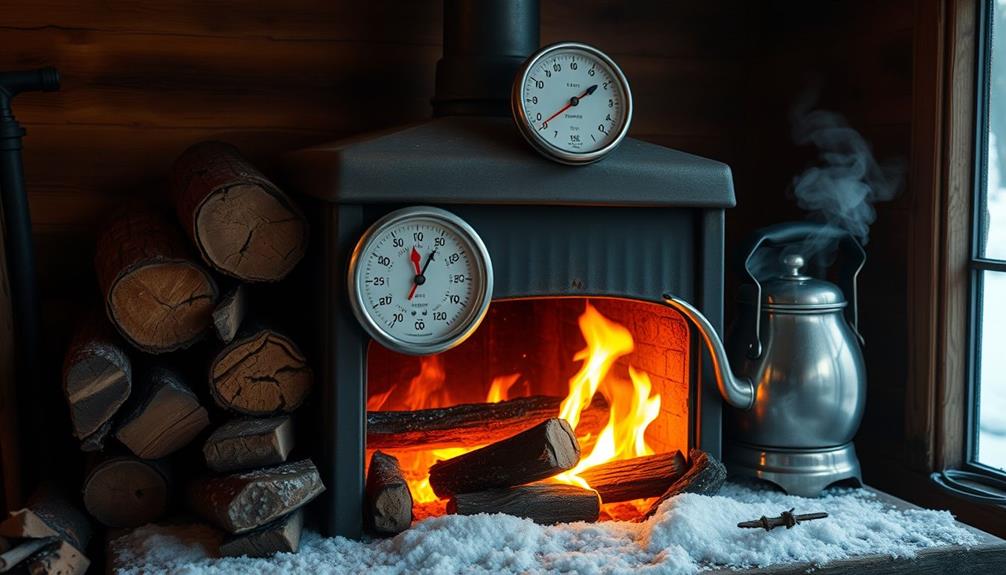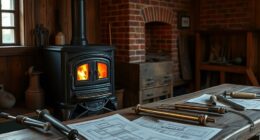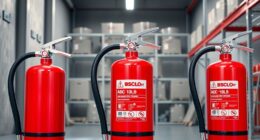To install a wood stove safely in your mobile home, first choose a stove approved for mobile home use. You need to maintain clearances of 18 inches in front and 12 inches on the sides and back. Construct a non-combustible hearth pad and use a double-wall stovepipe to reduce clearance needs. Install an outside air kit for better combustion and guarantee proper venting according to local codes. Don't forget to schedule regular maintenance and inspections to keep everything running smoothly. By following these steps, you'll be well on your way to safe and efficient heating this winter. There's more to uncover!
Key Takeaways
- Choose a mobile home-approved wood stove and verify it meets safety standards with a compliance tag.
- Construct a non-combustible hearth pad, extending 18 inches in front and 12 inches on sides.
- Maintain minimum clearances of 18 inches in front and 12 inches on sides and back to prevent fire hazards.
- Install a double-wall stovepipe for safe gas exhaust and reduced clearance requirements.
- Schedule annual chimney cleaning and inspections to ensure safety and optimal performance.
Benefits of Wood Stoves
Wood stoves offer numerous advantages that can considerably enhance your home heating experience. One of the most significant benefits is the substantial reduction in heating costs. When you switch from electric heating to wood stoves, you can see your monthly bills drop from $175-$225 to as low as $30-$40. Not only does this save you money, but it also provides a warm and inviting atmosphere during the chilly winter months, creating a cozy ambiance that electric systems can't match.
Additionally, investing in a wood stove can be a strategic choice for those looking to diversify their home energy sources, much like diversification reduces overall investment risk in a retirement portfolio.
Additionally, wood stoves serve as reliable backup heating sources during power outages. You'll have continuous warmth and comfort, even when the electricity goes out. Choosing mobile home approved stoves guarantees you can benefit from this reliable source of heat in your mobile home.
Moreover, using a wood stove promotes greater independence from utility companies, fostering self-sufficiency and potential long-term savings. When sourced sustainably, wood stoves also represent an environmentally friendly heating option. They contribute to reduced carbon footprints and responsible resource use, making them a smart choice for eco-conscious homeowners.
Installation Requirements

Before you begin the installation of your wood stove, make sure it's specifically approved for mobile home use, as this confirms compliance with safety standards and local building codes. You'll need to follow specific installation requirements to guarantee safety and efficiency.
First, install a hard ducting system for an outside air kit to improve combustion efficiency and comply with HUD guidelines for manufactured homes. It's also important to secure the stove to the floor, as permanent attachment is mandatory to prevent any movement.
Next, adhere to the clearance requirements: maintain a minimum of 18 inches in front of the stove and 12 inches on the sides and back. This spacing is essential for safe operation and compliance with regulations. Finally, construct a proper hearth pad using non-combustible materials to protect your floor from heat damage and embers.
| Requirement | Specification | Purpose |
|---|---|---|
| Stove Approval | Mobile home approved | Safety compliance |
| Outside Air Kit | Hard ducting system | Enhance combustion |
| Clearance Requirements | 18" front, 12" sides | Safety and operation |
| Hearth Pad | Non-combustible | Protects floor |
Safety Considerations

When installing a wood stove in your mobile home, you need to prioritize safety by selecting an approved stove and ensuring proper clearance and ventilation.
Regular inspections and maintenance practices, similar to those used for toilet maintenance practices, can help identify potential hazards early on.
Keeping a safe distance from combustible materials and performing regular maintenance will help prevent hazards down the line.
Let's explore these essential safety considerations to keep your home warm and secure.
Approved Stove Selection
Choosing a wood stove specifically approved for mobile home use is essential for ensuring safety and efficiency. These stoves are designed to meet stringent safety standards required for tight construction environments, making them suitable for your manufactured home installation.
Always look for a metal tag on the stove, which indicates compliance with mobile home regulations and provides vital details about the make, model, and necessary clearances. Additionally, keeping in mind the importance of essential oil safety can inform your decision-making process regarding any chemical compounds that may be present in your home environment.
If you have an older wood stove, be cautious; many of these models were manufactured before modern safety standards were established and may not be safe anymore. It's best to replace them with newer, certified models that have been tested by a HUD-approved laboratory, ensuring they meet the necessary performance and safety requirements for mobile homes.
Additionally, consider selecting models that come with safety features and efficiency certifications from recognized organizations. These certifications not only provide peace of mind but also assure you of compliance with safety regulations.
Clearance and Ventilation Requirements
Guaranteeing proper clearance and ventilation is crucial for the safe installation of a wood stove in a mobile home. First, adhere to the clearance requirements by maintaining at least 18 inches in front of the stove and 12 inches on the sides and back. This spacing prevents fire hazards and allows for safe operation.
Additionally, consider the safety features of your stove; models with advanced technology can enhance overall safety during operation, including features like auto-reverse and obstacle detection.
For ideal ventilation, consider installing a double-wall stovepipe; this reduces clearance requirements and guarantees the safe exhaust of gases. You should also utilize a hard ducting system for outside air intake, which enhances combustion efficiency and maintains indoor air quality.
Always follow local building codes and manufacturer guidelines regarding clearance distances to combustibles, as these can vary based on specific stove models.
Regular inspections are also crucial; clean the chimney to prevent creosote buildup, maintaining proper ventilation and minimizing the risk of chimney fires.
Regular Maintenance Practices
Regular maintenance practices are essential for the safe operation of your wood stove. To confirm your stove is functioning efficiently, schedule regular chimney inspections by certified professionals, like those from the National Fireplace Institute (NFI). This step is critical for preventing creosote buildup, which can lead to hazardous situations.
Additionally, just as with preventing species spread, it's important to keep your stove clean and free from any debris that could obstruct airflow. You should clean the stove and chimney at least once a year, or more often if you use it heavily.
Inspect the stove components, including seals and gaskets, every season to check for wear and tear. Remember, your stove must operate correctly to maintain safety.
Additionally, keep a fire extinguisher and smoke detectors near your wood stove. These tools are essential for enhancing safety and guaranteeing a quick response in emergencies.
Hearth Construction

When constructing a hearth for your wood stove, it's essential to prioritize safety and stability. A well-built hearth not only protects your mobile home but also guarantees compliance with stove manufacturers' guidelines.
Start by determining the desired size, using 2×4 boards as a base for structural support. Next, layer plywood over this base, creating a solid foundation.
It's also important to take into account the heating capacity of your stove, such as the Englander 10-Cpm, which generates up to 50,000 BTUs and is suitable for heating large areas. This can influence the size and materials needed for your hearth to guarantee it can withstand the heat generated by your stove, especially if you opt for wood pellet stoves that require proper ventilation and installation BTU rating of wood stoves.
Here's a simple checklist to follow for effective hearth construction:
- Use concrete board: Place it on top of the plywood for heat resistance, as it effectively withstands the heat from the stove.
- Extend dimensions: Make sure the hearth extends at least 18 inches in front of the stove and 12 inches on either side to shield against embers and intense heat.
- Tile the surface: Finish by tiling over the concrete board with heat-rated materials to prevent damage.
- Inspect regularly: After extended use, check the hearth for wear and tear to maintain safety and adhere to local regulations.
Wall Preparation

Before you engage in installing your wood stove, it's vital to prep the wall effectively. Start by removing the existing sheetrock from the wall where the wood burning stove will be installed. This step is imperative for making way for heat-resistant materials that'll keep your space safe from fire hazards.
Additionally, guaranteeing good air quality in your mobile home is important, so consider using an air purifier to help eliminate allergens and maintain a healthy environment.
Next, install concrete board as a base. This provides a stable and heat-resistant surface for tiling around the wood stove. Verify all materials you use, including the concrete board and tiles, are rated for high temperatures. This precaution helps prevent damage and reduces the risk of fire.
Once the concrete board is in place, consider using a heat shield on the wall behind the stove. This can notably reduce the required clearance, enhancing safety in the installation area.
Chimney Specifications

When it comes to chimney specifications, you'll want to pay close attention to pipe material requirements and venting clearance guidelines.
Confirming you select materials that can withstand the heat generated by your wood stove is essential for safety. Additionally, following proper clearances can help prevent any operational issues or potential fire hazards, similar to the considerations needed for heat pump failures.
Using the right materials guarantees safety and efficiency, while maintaining proper clearances keeps your home protected from fire hazards.
Let's explore what you need to know to keep your installation compliant and secure.
Pipe Material Requirements
Selecting the right pipe material for your wood stove is vital for guaranteeing safe and efficient operation. Using the appropriate materials not only enhances performance but also minimizes safety risks, particularly in a mobile home.
It's important to understand key factors in choosing a home cleaning service that apply similarly to guaranteeing a safe installation environment. Here's what you need to take into account:
- Double-wall stove pipe is recommended for its safety and efficiency. It maintains higher temperatures, reducing the risk of creosote buildup compared to single-wall pipes.
- Verify that the stovepipe diameter matches the flue size of your wood stove. Mismatched sizes can lead to inefficient burning and smoke issues.
- Use black stove pipe for interior connections, while a prefabricated chimney system should be installed for exterior venting. Make sure to follow local building codes during installation.
- Maintain proper clearance from combustible materials: single-wall pipes require an 18-inch clearance, whereas double-wall pipes typically need only 6 inches.
Always confirm that your chimney installation complies with HUD standards and local regulations, including proper support framing for the chimney pipe.
Venting Clearance Guidelines
How much clearance do you really need when installing a wood stove in a mobile home? Following venting clearance guidelines is vital for safety and compliance. You must maintain a minimum clearance of 18 inches in front of the stove and 12 inches on the sides and back. This spacing helps prevent fires and guarantees proper airflow.
Additionally, confirming your setup can withstand various scenarios can enhance your preparedness, especially in a mobile living situation where RV living offers mobility and flexibility.
For the stovepipe, double-wall stove pipes are highly recommended. They provide better insulation and require less clearance from combustibles compared to single-wall pipes. Always verify that the stovepipe diameter matches the wood stove flue size for peak operation and efficiency.
Use black stove pipe for the interior runs from the stove to the ceiling or wall, but avoid passing through walls or ceilings with stovepipes, as this can create fire hazards.
Regular inspections of both the chimney and stove installation are essential. These checks not only prevent fire risks but also maintain the stove's performance.
Fuel Sources and Efficiency

A wood stove can be an efficient and cost-effective heating solution for your mobile home, especially when you choose the right fuel sources. Shifting from electric heating can dramatically reduce your heating bills from $175-$225 down to as low as $30-$40.
However, to maximize efficiency and comfort, consider the following fuel sources:
- Seasoned Wood: Using seasoned wood minimizes smoke and emissions, enhancing heating efficiency and safety. Make sure to store it properly to maintain dryness.
- Fallen Trees: Accessing fallen trees for firewood can provide a sustainable and cost-effective fuel source, ensuring a continuous supply throughout the season.
- Wood Type: The selection of wood types affects burn efficiency; hardwoods generally provide more heat and longer burn times than softwoods.
- Coal: As an alternative fuel source, coal can offer long-term cost savings when sourced sustainably, making it a viable option for your stove.
Maintenance and Inspections

Proper maintenance and regular inspections are essential for keeping your wood stove running safely and efficiently.
Start by scheduling a chimney cleaning at least once a year, or more frequently if you use the stove often. This prevents creosote buildup, which can lead to dangerous chimney fires.
Additionally, inspect all stove components, including the flue, gaskets, and seals, at least annually. This guarantees peak performance and safety.
Don't forget to maintain a fire extinguisher and smoke detectors nearby, checking their functionality during routine maintenance.
To keep everything up to standard, schedule professional inspections by certified NFI professionals, especially for older models. They'll assess the safety and efficiency of your installation.
Frequently Asked Questions
Can I Install a Wood-Burning Stove in My Mobile Home?
Yes, you can install a wood-burning stove in your mobile home. Just make certain it's approved for mobile use, meets local codes, and has proper ventilation to guarantee safety and compliance with regulations.
Can You Install a Wood Stove in a Trailer?
When it comes to your trailer, you can definitely install a wood stove, but you've got to choose one specifically approved for mobile homes. Safety's key, so don't cut corners—follow the guidelines!
How Far off the Wall Does a Wood Stove Need to Be?
A wood stove should be at least 18 inches from the front and 12 inches from the sides and back of combustible materials. Always check manufacturer guidelines for specific clearance requirements to guarantee safety.
Can You Add a Fireplace to a Manufactured Home?
Yes, you can add a fireplace to a manufactured home, but it must be specifically approved for that use. Always check local codes and consult professionals to guarantee safety and compliance with regulations.
Conclusion
Installing a wood stove in your mobile home can transform it into a cozy haven during chilly nights, much like wrapping yourself in a warm blanket on a cold day. Just remember, safety is key—think of it as the sturdy foundation of your home. By following the guidelines for installation and maintenance, you can enjoy the warmth and comfort of your wood stove while ensuring your space remains safe and inviting for years to come.











